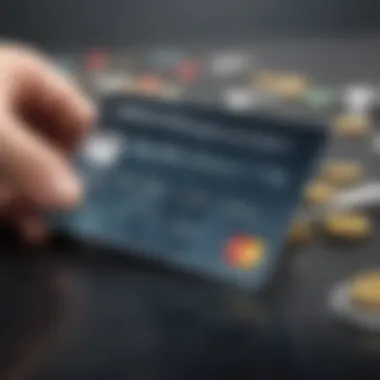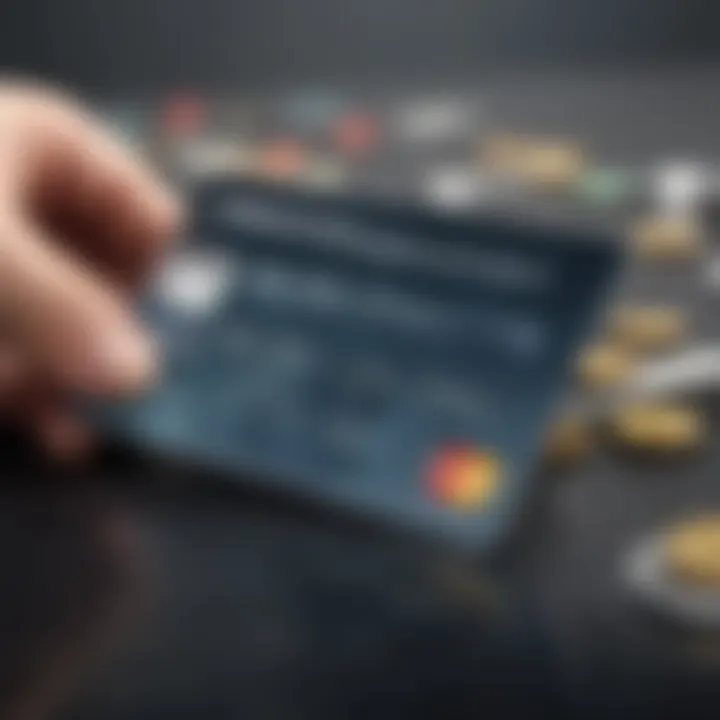Effective Strategies for Credit Card Debt Management


Intro
Managing credit card debt is a task all too familiar to many individuals. It can feel like a relentless cycle, where each month brings a new bill and the pressure mounts. But understanding certain strategies can alleviate some of this burden. It's essential to grasp not just how much to pay off, but also the nuances that come with credit card management. This section will pave the way for a deeper dive into the concepts and tactics surrounding paying off credit card debt.
Investment Dictionary
While the focus is on credit cards, the language used in this arena can often mirror that of investments. Knowing some key terms can aid in grasping the broader financial picture. Here we explore essential terminology, including:
Key Terminology Breakdown
- APR (Annual Percentage Rate): This is the yearly interest rate that reflects the cost of borrowing on your credit card. It's an important figure, as higher APRs can lead to significant debt accumulation.
- Balance Transfer: Moving the existing balance from one credit card to another, often to take advantage of lower interest rates. This can be an effective way to manage debt if done correctly.
- Minimum Payment: The smallest amount you must pay to keep your account in good standing. While it might seem convenient to only pay this amount, doing so can prolong debt and increase interest costs over time.
Understanding these terms can enhance one's ability to strategize when managing debt better.
Psychological Factors in Debt Repayment
When it comes to credit card repayments, the psychological aspect can’t be ignored. How we perceive debt, our emotional responses to financial stress, and our spending habits all play crucial roles in shaping our repayment strategies.
- Fear of Missing Out: This often leads individuals to make impulsive purchases. Recognizing this tendency can help in curtailing unnecessary spending.
- Pride and Shame: Social perceptions around debt can create emotional burdens. Accepting one’s financial situation is the first step toward improvement.
Strategies to Consider
As we journey deeper into managing credit card debt, fostering an understanding of various strategies is essential.
- Debt Snowball Method: This approach focuses on paying off the smallest debts first, allowing for quick wins that can motivate continued progress.
- Debt Avalanche Method: Alternatively, this technique prioritizes debts with the highest interest rates. This may seem daunting but can save money in the long run.
Both methods have their pros and cons, and the ideal choice often depends on individual preferences and financial circumstances.
"Understanding your debts is the first step to taking charge of your financial future."
Implementing the right repayment strategy requires diligence and commitment. The more one understands their financial behavior and the complexities of interest rates, the better equipped they will be to pay off that debt. In the following sections, we will further break down actionable steps to equip readers with the tools they need for financial empowerment.
Understanding Credit Card Debt
Credit card debt is an ever-present reality for many individuals, shaping not just their financial landscape, but also their emotional wellbeing. Understanding the nuances of credit card debt is critical, as it provides the groundwork for effective repayment strategies. This section aims to shine a light on the core aspects of credit card debt, unraveling its complexities so readers can navigate their own financial journeys more confidently.
Defining Credit Card Debt
At its essence, credit card debt is the amount of money owed on credit cards after purchases are made. It arises when cardholders spend beyond their means or fail to pay off the total balance within the grace period. Think of it like borrowing from a friend who charges interest—ideal for short-term needs, but it can quickly turn sour if not managed wisely.
Credit card debt is unique because it often carries high-interest rates compared to other forms of borrowing, such as personal loans. The minute an individual misses even a single payment, the balance can balloon significantly. An important figure to keep in mind is the Average National APR for credit cards, which is approximately 16%—just imagine how that stacks up with missed dues.
Why Credit Card Debt Matters
Understanding why credit card debt matters is crucial for making mindful financial decisions. Let’s break it down:
- Financial Health: High levels of credit card debt can lead to financial distress. It can deter individuals from saving, investing, or affording daily expenses. If you’re constantly paying off debt, a stable financial future feels out of reach.
- Impact on Credit Score: Credit card debt plays a vital role in determining your credit score, which affects everything from loan approvals to interest rates. If you run up credit card balances, your credit utilization ratio takes a hit, and that could trip up loans for a car or even a home.
- Interest Accumulation: Think about a snowball rolling down a hill, gaining speed and size as it descends. High-interest rates can lead debts to grow at alarming rates. Knowing how much you owe and how long it’ll take to pay it off is not just beneficial, it’s imperative.
- Mental Strain: The mental burden of credit card debt is often overlooked. Financial anxiety is real, and it can seep into personal relationships and overall quality of life. Tackling credit card debt doesn’t just improve balance sheets; it can offer peace of mind.
"Financial freedom is available to those who learn about it and work for it." – Robert Kiyosaki
Delving into the nature of credit card debt enables individuals to see not just the figures on a statement, but the broader implications of that debt. Each dollar borrowed reflects on your life choices and financial literacy. Understanding these dynamics sets the stage for smarter strategies in paying off that debt, ultimately leading to a sounder financial future.
Assessing Your Current Financial Situation
Assessing your current financial situation is akin to standing at the crossroads before setting out on a journey. It’s crucial to get an accurate picture of where you are so you can make informed decisions about how to tackle credit card debt. Understanding both your income and expenses can highlight areas where adjustments might be necessary. Analyzing your financial habits and being honest about your spending behavior cultivates a foundation for successful debt repayment.


Being fully aware of your income allows you to map out your resources effectively. You might earn a fixed salary or have variable income based on commissions or freelance work. Part of this assessment includes acknowledging the bills that come due each month and having a solid grasp of everyday expenses. The interplay between these two elements helps clarify how much disposable income is realistically available for debt repayment.
Analyzing Your Income and Expenses
To dig deeper into your financial situation, start by creating a comprehensive list of all sources of income. Consider not just your salary but also side hustles, rental income, or even dividends from investments. Once your total monthly income is accounted for, it’s time to pivot to expenses. It’s easy to overlook small outlays like that daily coffee or weekly takeout; they add up faster than you might think!
- Fixed Expenses: These are the regular payments you can't evade—like rent/mortgage, utilities, and minimum credit card payments.
- Variable Expenses: This can encompass anything from groceries to entertainment. Tracking these can help identify frivolous spending habits.
By writing everything down, you cultivate not just clarity—but also accountability.
Evaluating Your Credit Card Balances
After you’ve gathered your income and expenses, it's time to turn attention to your credit card balances. This involves collecting the total balance from each card and jotting down the interest rates associated with them. Knowing exactly how much you owe gives you a springboard for crafting a solid repayment strategy.
Also, consider breaking down your balances into categories:
- Revolving debt: This is what creepily accrues if not managed; think unsustainable charges that roll over month to month.
- Installment debt: Considered healthier; this is more stable with a defined payback period like personal loans.
"The first step towards managing debt is knowing what's on your plate."
Understanding Your Credit Card Interest Rates
Credit card interest rates can feel like a heavy anchor if not understood thoroughly. Look closely at how these rates play into your overall debt picture. A high annual percentage rate (APR) can significantly influence how long it takes to pay off a card when only making minimum payments.
Establish if your interest rates vary: Many cards offer promotional rates that might eventually spike after a period, introducing uncertainty in your planning. Furthermore, different cards often mean different terms; you might have a low-interest card paired with one that carries a heftier rate.
A simple list of your credit cards, alongside their respective APRs and balances, can make this analysis clear. Here’s an example of what this might look like:
| Credit Card | Balance | APR | | Chase Freedom | $2,000 | 15.99% | | Discover It | $1,200 | 20.49% |
Understanding your situation equips you with the insight needed to make informed strides toward paying off credit card debt, setting the stage for a more secure financial future.
Determining a Payment Strategy
Making a solid plan for tackling credit card debt is crucial. This isn’t just about paying bills; it’s about securing financial freedom and peace of mind. A well-crafted strategy helps in mapping out the journey towards becoming debt-free. It plays a significant role in not only reducing the overall amount owed but also in deciding how to allocate your funds efficiently.
Understanding the intricacies of various payment methods can transform the way you handle debt. Whether you choose to pay minimum amounts, prioritize certain debts, or select a particular method to tackle payments, these choices significantly affect your financial landscape. The goal here is to make your payments efficient and effective—so you aren’t just throwing money at debt without a clear direction.
Minimum Payments: Are They Enough?
A common misconception is that making the minimum payment is sufficient to manage credit card debt. While it allows you to avoid late fees and maintain an active account, there are deeper implications.
When one only makes the minimum payment, the bulk of the money goes towards interest charges rather than reducing the principal. In a nutshell, this strategy is like running on a treadmill—you’re moving but not getting anywhere. Over time, the debt can grow larger, causing stress and prolonging the journey to becoming debt-free. It's essential to understand that consistently only paying the minimum can leave you in a financial quagmire.
Prioritizing Debt Payment
How you prioritize your payments matters a great deal. It can feel overwhelming when faced with multiple credit cards and various balances. However, there are two viable strategies for prioritizing:
Highest Interest First
The methodology of tackling the highest interest first can save a significant amount of money over time. This approach involves focusing your funds on the card with the steepest interest rates while maintaining the minimum payments on others. It’s often favored because it directly addresses the costliest aspect of credit card debt. The idea is quite simple: eliminate the debt that costs you the most.
This method has its unique features:
- Cost Efficiency: Paying off high-interest cards reduces interest accrual, translating into long-term savings.
- Psychological Advantage: Once a high-interest debt is gone, the relief can boost motivation to continue the debt repayment journey.


However, it’s important to note that sticking with this method requires discipline. There’s a psychological tax that can accompany focusing solely on higher interest debt; frustration may arise if other debts remain unpaid longer than preferred.
Lowest Balance First
Alternatively, the lowest balance first method enjoys popularity for its simplicity and psychological quick wins. By paying off the smallest balances first, you can see debts vanish quickly, providing a sense of accomplishment.
Key characteristics include:
- Quick Wins: Paying off smaller debts can offer immediate relief, motivating you to tackle larger sums next.
- Increased Confidence: Watching accounts get closed can be a powerful motivator, making the overall debt seem less daunting.
Yet, while this method has its perks, it often leads to higher overall interest costs. It’s like making a dish for a group by frying up the small veggies first; you might feel satisfied, but some of those bigger ingredients still need to get cooked eventually. Balancing these approaches—quick wins versus long-term savings—can prove challenging.
Snowball vs. Avalanche Methods
Both Snowball and Avalanche methods offer structured approaches to debt repayment. The Snowball Method emphasizes paying off the smallest debts first, engendering quick victories and motivation. In contrast, the Avalanche Method aims at minimizing interest payments by prioritizing the highest-interest debt.
Choosing between these strategies ultimately reflects personal preferences and psychological considerations. Consider what motivates you most and how each method aligns with your long-term financial goals. It is important to weigh advantages against your personal temperament and financial situations.
Setting a Realistic Payment Amount
When it comes to credit cards, understanding the art of making smart payments can be the difference between drowning in debt and steering towards financial stability. Setting a realistic payment amount is crucial; it’s not about paying off the debt in a hurry but rather finding a balance that fits your lifestyle while also aggressively addressing that balance. This harmony can lead to achieving financial peace of mind.
Calculating Your Disposable Income
To start carving out a payment plan, take a close look at your disposable income. This is the money left in your pocket once you've paid bills and basic living expenses. Calculating your disposable income allows you to figure out how much you can realistically allocate towards your credit card payments each month without starving your other needs. Here’s a simple approach:
- List Your Income: Gather all sources of income — salary, freelance gigs, anything that brings in cash.
- Itemize Essential Expenses: Make a list of your essential monthly expenses: rent, utilities, groceries, and transportation. Don't forget any non-negotiables like insurance premiums or debts.
- Subtract to Find Disposable Income: Once you’ve laid out your income and expenses, subtract the total expenses from your total income. What remains is your disposable income. This will give you a solid figure to work with when budgeting your credit card payments.
Incorporating Savings into Your Plan
While it might seem logical to plow every spare dollar into debt repayments, don’t neglect the savings part. Saving should be included in your financial strategy. Life throws curveballs; having a safety net can prevent slipping back into debt. When setting your payment plan, consider incorporating a small amount for savings, even if it's minimal. Splitting your disposable income could look something like this:
- 50% for debt payments
- 30% for savings
- 20% for everyday expenses or fun (yes, deliberate enjoyment is essential)
This ensures you’re not just paying off debt but also preparing for future financial needs, letting you sleep a little easier at night.
Adjusting Payments Based on Financial Changes
Life is unpredictable; some months you might find yourself flush with cash while others have you scraping pennies. Adjusting your payments based on financial changes is vital for maintaining control over your credit card debt. If you get a bonus at work or a side project that pays off, don’t be shy to increase your payment. Conversely, if unexpected bills arise, it’s okay to lower your payments temporarily. The aim is to remain flexible but committed in your approach. Here are some guidelines to keep in mind:
- Regularly Review Your Budget: Set a reminder to revisit your budget monthly. This gives you the chance to assess any financial changes stemming from a pay raise, a change in job status, or even unexpected expenses like medical bills.
- Keep a Buffer: Having a little extra set aside for those tricky months where your income fluctuates can make a world of difference. This practice can soothe the nerves if life throws surprises your way.
"Adaptability is about the powerful difference between adapting to cope and adapting to win."
By taking the time to assess your financial situation, you can make informed decisions that reflect where you are in your financial journey. Careful calculation, a commitment to saving, and adaptability to change are the keys to effectively managing credit card payments. With the right strategies in your pocket, you can tackle that credit card debt head-on.
The Psychological Impact of Credit Card Debt
Credit card debt often carries with it more than just financial implications; it weaves its way into the fabric of one’s mental well-being. The experience of being weighed down by debt can shape a person’s emotions, thoughts, and behaviors, affecting everything from sleep to decision-making capabilities. Therefore, understanding the psychological impact of credit card debt cannot be understated. This section aims to shed light on the nuances of financial anxiety and discipline, providing insight into ways individuals can navigate their emotional landscape while addressing their debt.
Understanding Financial Anxiety
Financial anxiety commonly manifests as a lingering feeling of unease concerning money—specifically debt. For those under the shadow of credit card obligations, this type of anxiety can be extremely potent. It may lead to a cycle of despair; the more one worries about meeting payment deadlines, the more stressed one becomes, often leading to procrastination or avoidance.
The following aspects highlight this relationship between credit card debt and anxiety:


- Constant Worry: Individuals might find that their minds race with thoughts about outstanding balances, upcoming bills, or interest rates, which takes a toll on mental health.
- Social Isolation: Fear of judgment or shame may prevent people from seeking support or discussing their situation with family and friends.
- Impact on Relationships: Financial stress can introduce strain into personal relationships, leading to conflicts over spending habits or differing financial goals.
Moreover, recognizing that one's emotional response to debt is common can help in alleviating some of that pressure. Rather than approaching financial discussions from a standpoint of taboo, fostering an open dialogue can better equip individuals to manage their financial anguish.
The Role of Discipline in Debt Management
Building discipline in managing credit card debt resembles cultivating a muscle – it requires effort and consistency. Discipline allows individuals to structure their financial choices in a way that fosters progress toward a debt-free lifestyle. The journey can be exhausting, yet the sense of control that comes from disciplined habits can prove invigorating.
Achieving financial discipline involves several key strategies:
- Sticking to a Budget: Creating a comprehensive budget enables individuals to allocate specific amounts toward debt repayments, ensuring they focus on eliminating their liabilities.
- Regular Review: Frequently checking one’s financial situation helps to maintain awareness about spending patterns and debts due.
- Setting Realistic Goals: Setting achievable targets for paying off debt fosters a sense of accomplishment, boosting motivation over time.
"Discipline is the bridge between goals and accomplishment."
It’s crucial to remember that without discipline, good intentions can easily slip through the cracks. By developing a structured approach to payments and maintaining control, individuals can begin to mitigate the anxiety surrounding their credit card debt.
Understanding these psychological aspects is instrumental in not only formulating a practical plan for tackling debt but also in enhancing quality of life. By addressing the emotional undercurrents connected to credit card debt and fostering discipline, one can reclaim their peace of mind, paving the way for smart financial practices.
Long-Term Considerations
When it comes to managing credit card debt, many people focus solely on the immediate goal of paying off their current balances. While this urgency is understandable, overlooking long-term considerations can be like running a race with blinders on. It’s essential to think beyond the present and recognize how your strategies today can influence your financial future.
Impact on Credit Score
One of the most significant consequences of handling credit card debt is its effect on your credit score. A healthy credit score is not just a number; it plays a crucial role in your financial well-being. For instance, it affects your ability to secure loans, qualifies you for better interest rates, and can even influence rental applications. Credit scores are calculated using several factors, with credit utilization and payment history being paramount.
- Credit Utilization: This measures how much credit you’re using compared to your total available credit. Ideally, keeping this ratio below 30% is advisable. If you're racking up balances close to your limit, your score takes a hit.
- Payment History: Consistently making on-time payments can boost your score significantly. A missed payment may seem trivial in the moment, but it can linger on your report for years, dragging down your score.
By prioritizing debt repayments and monitoring your credit usage, you can prevent unfavorable long-term effects that might shadow your financial life.
Strategies for Maintaining a Healthy Credit Profile
So how can you ensure that your credit profile remains healthy over the long haul? It requires a blend of strategy, discipline, and a pinch of foresight. Here are some effective strategies:
- Establish Automatic Payments: Set up automatic payments for at least the minimum due. This way, you won’t miss deadlines, which can hurt your credit score.
- Maintain Low Balances: Keep your credit card balances low. Aim to cover your purchases as you go, rather than letting them pile up.
- Diversify Your Credit Portfolio: Consider having a mix of credit accounts, such as installment loans and revolving credit. Diverse types of credit can positively impact your score.
- Check Your Credit Report Regularly: Don’t just accept your score; know what factors contribute to it. Identifying errors or fraudulent activity early allows you to rectify these issues before they wreak havoc on your finances.
- Limit New Credit Applications: Each time you apply for new credit, a hard inquiry can affect your score. Only apply for new accounts when necessary, promoting prudent credit management.
By consciously implementing these strategies, you can not only work towards paying off your credit card debt, but also cultivate a robust credit profile that stands the test of time.
Remember, every little decision counts when it comes to your financial health. Small, careful actions today can lead to significant benefits down the road.
Resources and Tools for Debt Management
Managing credit card debt effectively requires more than just determination; it needs smart strategies and the right tools. This section explores various resources and tools that can make the journey of paying off credit card debt more manageable. Whether it’s tracking your expenses, creating budgets, or obtaining advice from professionals, understanding these elements can significantly streamline your payment strategy. Many individuals often underestimate the value of these resources, thinking they can do it alone. However, leveraging technology and expertise can tilt the scales in your favor, providing clarity and a structured approach to tackling debt.
Apps for Budgeting and Payment Tracking
In today’s digital world, apps are a game changer for anyone looking to take control of their finances. Budgeting apps facilitate organization and offer insight into spending habits. For instance, apps such as Mint and You Need A Budget (YNAB) provide visual representations of your financial landscape, making it easier to allocate funds towards debt repayment.
- Real-time tracking: You can link your bank accounts and credit cards, allowing for automatic updates on your spending. This way, you nip any overspending in the bud.
- Goal setting: Many budgeting apps allow you to set specific goals, such as "paying off credit card debt by the end of the year." This serves as a motivator and helps create a sense of accountability.
- Custom alerts: Some apps send alerts when you approach your budget limits or when payment due dates are nearing.
For anyone struggling with financial discipline, these features can transform the way you manage your money, offering a clearer pathway toward debt freedom.
"Without the right tools, navigating financial waters can feel like sailing a ship without a compass."
Consulting Financial Advisors
Engaging with a financial advisor can provide invaluable insights tailored to your specific situation. Often, individuals may shy away from this step due to perceived costs or worries about their own financial literacy. However, a financial advisor can elucidate complex financial issues that might be holding you back from efficiently paying off your debt.
- Personalized plans: Unlike generic advice, an advisor crafts a plan that fits your financial circumstances, including income, expenses, and objectives.
- Debt reduction strategies: They can offer specialized knowledge on methods tailored for your needs, like assessing whether to consolidate your debt or negotiate better terms with creditors.
- Emotional support: Financial challenges can be stressful, and having someone who understands your situation can ease that burden. They can help you stay focused and motivated, especially during tough times.
While some may view consulting a financial advisor as an added expense, the potential benefits of knowledgeable guidance can outweigh the costs, potentially saving you money and stress in the long run.
In summary, employing tools like budgeting apps and seeking advice from financial professionals enhances your ability to manage credit card debt effectively. These resources empower you with information, clarity, and tactics that encourage a personalized approach to debt repayment.







